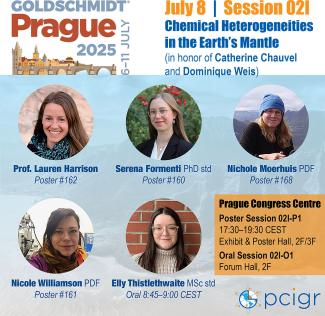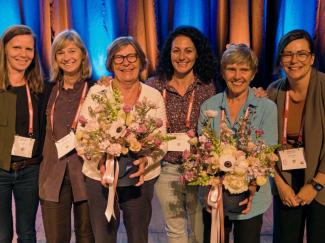Another successful and productive Goldschmidt conference has wrapped up!

Last week, PCIGR team members presented posters and a talk to great fanfare at a special session in honour of Catherine Chauvel (Institut de Physique du Globe de Paris) and Dominique Weis (PCIGR Director, Professor).
Presentations covered topics from mantle compositions in the Hawaiian Plume to fractionation of mantle-derived magmas of the Skaergaard Intrusion.
The session was convened by Marion Garçon and Maud Boyet (Université Clermont Auvergne), Nadine Mattielli (Université Libre de Bruxelles), Lauren Harrison (Colorado State University), Nicole Williamson (UBC), and Laura Bilenker (Auburn University).

Ahead of the conference, PCIGR opened its doors to Targeted Film production company for a look behind-the-scenes at the type of research conducted at our facility and in partnership with the Mineral Deposit Research Unit (MDRU) at UBC.
The video featured interviews with Professors Weis, Julie Prytulak and Shaun Barker (MDRU Director), PCIGR researchers Dr. Corey Wall and Dr. Marg Amini, and PCIGR students Emma Betz (PhD candidate), Brook Hoppstock-Mattson (PhD candidate) and Marium Ahmed (MSc student in soil science, co-supervised by Dr. Weis and Prof. Jean-Thomas Cornelis from the Faculty of Land and Food Systems).
While Dr. Weis was in Prague attending the Goldschmidt conference, she was interviewed by the European Association of Geochemistry about having a special session named in her honour and her take on the future of mantle geochemistry. You can read the blog here:
Goldschmidt special session description:
This session aims to celebrate the scientific achievements and outstanding contributions made by Catherine Chauvel and Dominique Weis to our understanding of mantle geochemistry. The chemical composition of the Earth's mantle has continuously evolved since the formation of the Earth. Early differentiation, continental crust extraction and subduction of oceanic plates and sediments have generated chemical heterogeneities that are nowadays sampled in a wide variety of geodynamic settings (arc, mantle plumes, large igneous provinces, etc.). Elemental and isotopic analyses, including radiogenic (Sr, Nd, Pb, Hf, W, noble gas) and stable isotopes (Li, C, O, S, Fe, Tl) of mantle-derived rocks are keys to gain insights into mantle composition and its evolution through time, the preservation of early-formed mantle reservoirs, crustal recycling processes, and core–mantle interactions. We encourage all contributions from geophysics, petrology, numerical modelling, and geochemistry to build a deeper understanding of the composition of the Earth's mantle.